Sometime around July 8 to 11, this article made the rounds. It is an article that just won’t vanish, and as it’s passed around, the claims about it get more extreme.
They completely misread the paper, which does not compare cloth masks to “no masks”. They compare medical masks and cloth masks to standard practice, where people wore masks.
People were tweeting things like this:


I don’t think they did that.
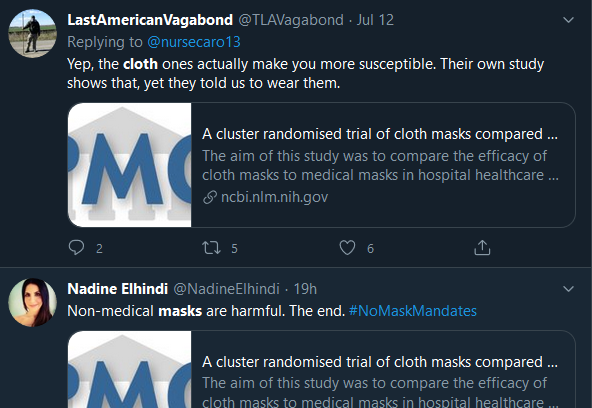
More susceptible? I don’t think so.
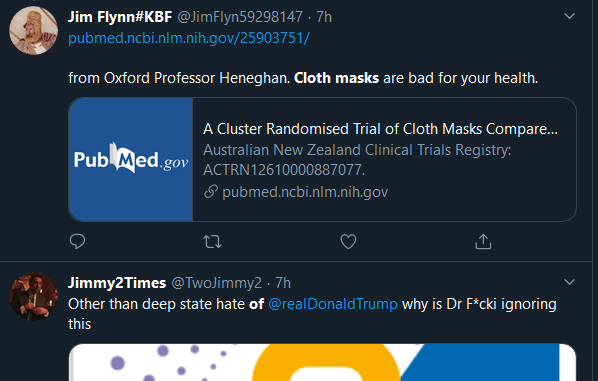
What the hell? Are they saying the masks are causing people to get sick?
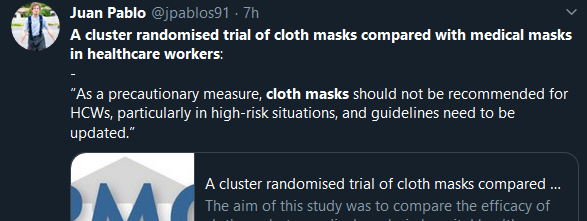
This last guy is actually not that bad. The study did specify this was about healthcare workers in high risk situations. We aren’t in high risk situations (unless we live with someone with SARS-CoV-2).
But, I digress.
The big problem with all these tweeters, and the hundreds passing this article around, claiming, or implying that cloth masks are worse than not wearing a mask, is that the article doesn’t say that.
At all.
The paper just says HCW who used only medical masks didn’t get sick as often as those who used only cloth masks.
The study had a “control group”, which wasn’t really a control group, who used standard procedures. Standard procedures were not described, but appeared to mean “wear masks.” More people used medical masks than cloth masks. Only two people did not wear masks at all.
I suspect that people making claims about the article, and sharing the URL to it, didn’t read it.
When I read the article, I didn’t find much to disagree with, at first.
It seemed obvious: if you wear a cloth mask, it gets nasty. If you wear a medical mask, it’s made of a synthetic material, and it dries off faster.
However, a poster on reddit made a good point, that the medical mask arm were given two new masks each day, while the cloth mask arm were given five masks to rotate, and wash on their own. That seemed a little “rigged” to me.
Getting back to these people who post the link. Some are posting the BMJ copy, and that website has a comment by the authors of the article, about COVID-19 and masks. They basically say this study concerns health care workers.
Right at the top of the article, it says there’s a comment. It even shows up on the twitter preview.

Here’s the page:
https://bmjopen.bmj.com/content/5/4/e006577.long
If you don’t want to read it now, here’s that notice, right in the paper!
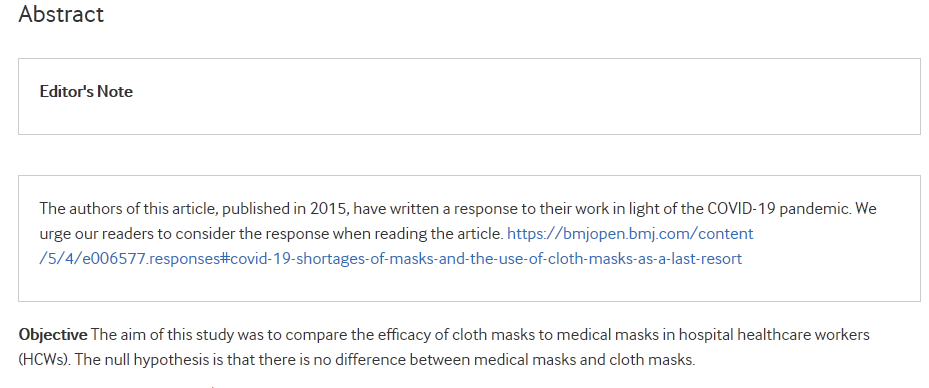
I notice, in the comments, they kept talking about healthcare workers, and not the general public.
I also noticed at the end, they had a little disclaimer of a conflict of interest:
“Conflict of Interest:
“We were the authors of the 2015 RCT , which was funded by an Australian Research Council Linkage Grant with 3M as the partner on the grant.”
That means 3M paid for the paper. They also noted in the paper’s conflict of interest section:
“Competing interests – CRM has held an Australian Research Council Linkage Grant with 3M as the industry partner, for investigator-driven research. 3M has also contributed masks and respirators for investigator-driven clinical trials. CRM has received research grants and laboratory testing as in-kind support from Pfizer, GSK and Bio-CSL for investigator-driven research. HS had a NHMRC Australian-based Public Health Training Fellowship at the time of the study (1012631). She has also received funding from vaccine manufacturers GSK, bio-CSL and Sanofi Pasteur for investigator-driven research and presentations. AAC used filtration testing of masks for his PhD thesis conducted by 3M Australia.”
I wondered if this was the scientists’ way of saying, hey… maybe you want to consider that we’re in the mask business, indirectly.
I was trolling someone, not the person below but someone else, and they whipped out this quote from the paper, that 97% of particles penetrate the cloth mask.
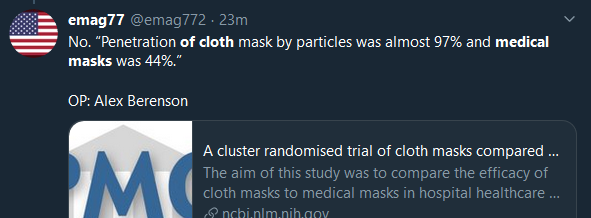
That line is in there.
When I wear a mask, it gets a little damp on the inside, while the outside stays dry.
If 97% of my breath penetrated the mask, then the two sides would be nearly equally damp, and would be pretty dry.
So, I went into the article, again, to see how they tested it.
They used a machine, the TSI 8110 Filter tester. They benchmarked it with a 3M N95 mask. Here’s the patent for the device, so you can see how it works:
https://patents.google.com/patent/US5059348A/en
The title of the patent is: “Method for measuring the efficiency of gas mask filters“
The machine produces tiny particles around 0.2um:

I’m impressed that medical masks stopped over 50% of these tiny particles.
So, anti-mask tweeters claim that masks don’t block anything, when, in fact, they were tested to see if they block only a specific range of small particles. Our breathing and talking produce a wider range of sizes.
Some websites say the SARS-CoV-2 is around 125nm, which is 0.125µm. So the particles produced by the machine are representative of a single viral particle, and the cloth masks do not stop single particles of virus. Medical masks stop around half of them.
However, as stated in many articles, viruses are inside moisture droplets.
I wondered what human droplet sizes were. This paper says the particle sizes range, the droplets get pretty large when people are speaking.
Distinct physiological processes were responsible for specific size distribution modes. The majority of particles for all activities were produced in one or more modes, with diameters below 0.8 µm. That mode occurred during all respiratory activities, including normal breathing. A second mode at 1.8 µm was produced during all activities, but at lower concentrations.
Speech produced particles in modes near 3.5 µm and 5 µm. The modes became most pronounced during continuous vocalization, suggesting that the aerosolization of secretions lubricating the vocal chords is a major source of droplets in terms of number.
So, it looks like the testing machine produces particles that are smaller than the particles we exhale, but they are similar to the size of a coronavirus.
I’m going to digress and show a chart showing that when people talk, they produce a lot more particles than when they breathe.
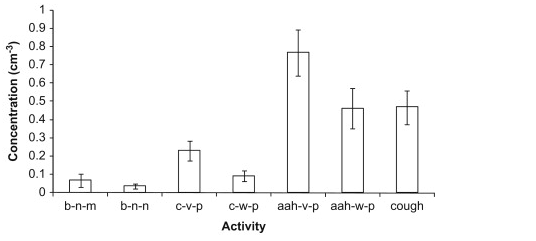
It’s a fascinating paper, and I found a pdf copy here. It explains a lot, but also left a lot to be discovered and studied.
The concentration of particles, and the size of particles, increase when people talk. Maybe that’s expected, but the fact we’ve seen so many infections at home, and at churches, and other places where people are talking indoors, just makes me wonder if speaking is how this virus is transmitted.
So, people exhale submicron particles while breathing, and masks may not stop these particles — but we don’t know, because this test used particles smaller than what we exhale. People also exhale much larger particles while doing other activities or talking.
We see evidence that countries with policies to wear masks suffered less from COVID-19.
There’s also some news reports of hair stylists failing to transmit COVID-19 while wearing masks. However, we know they could infect people, because one stylist shared the illness with her family, and got some members sick.
Could it be that COVID-19 spreads mainly in the larger particles? Does the infectious dose matter? Does wearing a mask to prevent spread work? (I definitely think it does.)
There’s a lot of unknowns, but there’s also plenty of stuff to read, to get insight into the situation.
Update July 18, 2020
I found a paper that measured droplets emitted while speaking, and theorized about what’s happening to them. The airborne lifetime of small speech droplets and their potential importance in SARS-CoV-2 transmission.
That article is really mind-blowing, and I’ll probably need to revise this post substantially.
I also found this: Database of Superspreader Events. A quick search for “movies” or “audience” showed nothing about transmission at the movies. People go to the movies, and stay quiet.
Meanwhile, sporting events, churches, and work are common on the list. These are places where people talk or yell.
(If you’re wondering about my position on masks – I’ve been pro-masking and pro-cloth-masks since mid-March, a few days before the City of LA started to recommend masks. I just figured they seemed to work in Asia, so, just copy what they were doing. It pretty much amounted to monkey-see-monkey-do superstition, but… there is something to be said for emulating success. There’s now papers saying, yes, masks worked in these countries.)
Update, August 11, 2020
A few different studies about the effectiveness of different materials have been published. One was by MacIntyre, who wrote the 2015 RCT paper: A rapid systematic review of the efficacy of face masks and respirators against coronaviruses and other respiratory transmissible viruses for the community, healthcare workers and sick patients. This has a useful summary of papers.
And another one: Physical distancing, face masks, and eye protection for prevention of COVID-19 by MacIntyre.
There’s an upcoming paper that MacIntyre is writing: Effectiveness of Cloth Masks for Protection Against Severe Acute Respiratory Syndrome Coronavirus 2 by Chughtai.
Several articles test different fabrics:
Filtration Efficiencies of Nanoscale Aerosol by Cloth Mask Materials Used to Slow the Spread of SARS-CoV-2 by Zangmeister.
Aerosol Filtration Efficiency of Common Fabrics Used in Respiratory Cloth Masks by Konda.
Performance of fabrics for home-made masks against spread of respiratory infection through droplets: a quantitative mechanistic study by Aydin. This is a pre-print.
Quantitative Method for Comparative Assessment of Particle Filtration Efficiency of Fabric Masks as Alternatives to Standard Surgical Masks for PPE by Mueller. This is a pre-print. One thing I noticed is they used a particle generator, similar to what MacIntyre 2015 did.
This last, most recent one, says “gaiters” are worse than no mask at all, and bandanas aren’t useful: Low-cost measurement of facemask efficacy for filtering expelled droplets during speech by Fischer.
For this last one, I made a meme:

Visualizing the effectiveness of face masks in obstructing respiratory jets by Verma, published in June, showed the flow of simulated breaths, showing how to set up a similar illumination system.





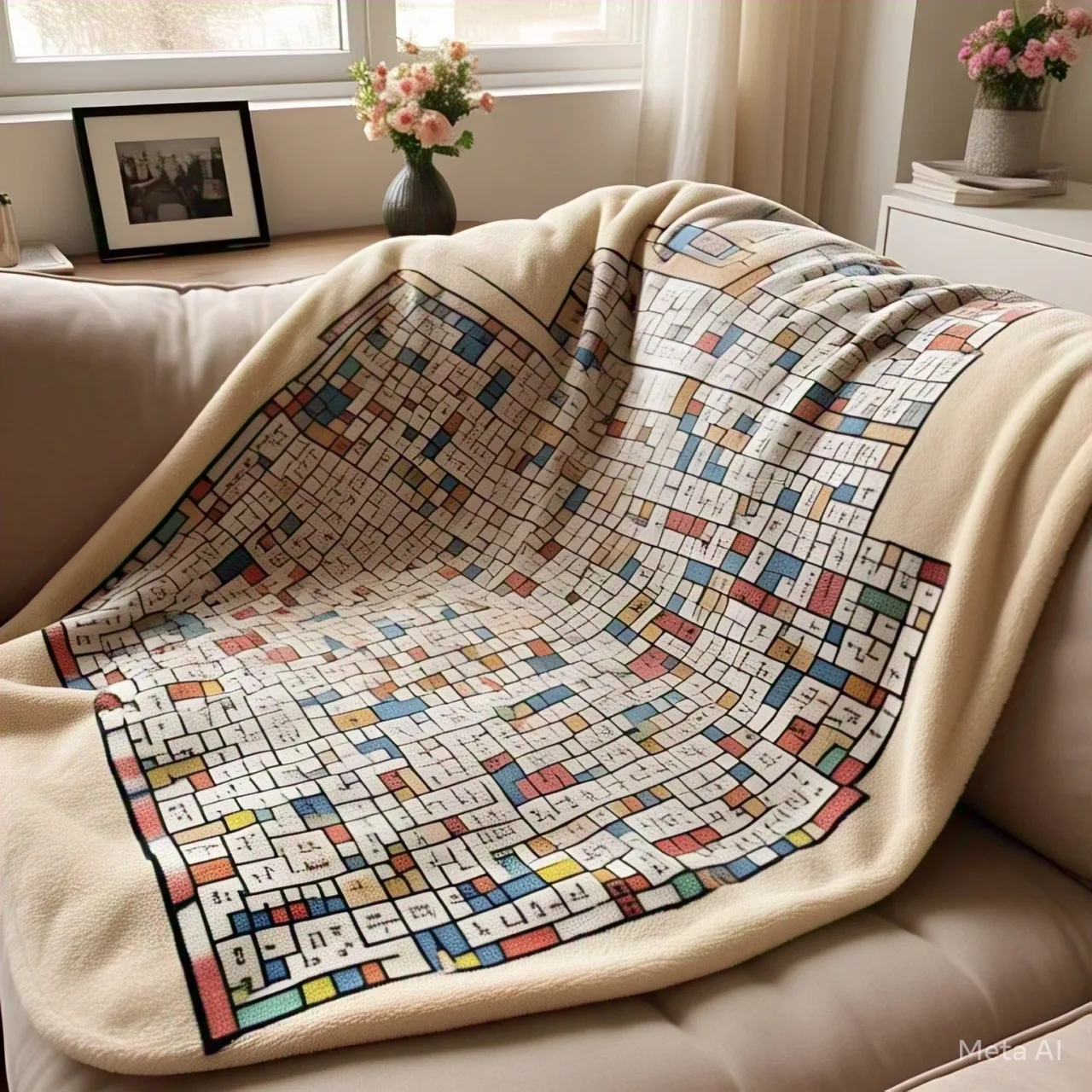
Leave a Reply